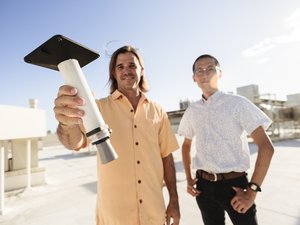The concept of diversifying Hawaii’s economy through technology is nothing new.
The state agency that is responsible for doing just that, the Hawaii Technology Development Corporation, or HTDC, has been around since 1983, so it’s an effort at least 40 years in the making.
However, during Pacific Business News’ annual Technology Roundtable, Eddie Ontai, the president of IT company DataHouse, said that there are more concerted efforts toward this goal now than ever before.
“Never have we seen something like this where there’s so many community initiatives related to technology, whether it be on the demand side of tech-enabling organizations, or on the supply side of creating workforce development efforts,” Ontai said.
This year’s Technology Roundtable, held virtually on April 4, focused on those topics: efforts to diversify the economy through technology, and workforce development in the sector. PBN gathered representatives from some of the businesses and organizations working in these areas, with Ontai joined by Sandra Fujiyama, executive director of the Pacific Asian Center for Entrepreneurship at the University of Hawaii at Manoa; Len Higashi, executive director of HTDC; Donavan Kealoha, co-founder and CEO of Purple Maia Foundation; and Jordan Oliver, esports manager at Hawaii Pacific University.
What follows is an overview of some of their key initiatives toward these goals and other highlights from the conversation.
Fostering a diverse economy
When it comes to the idea of how to diversify the economy through tech, Len Higashi kicked off the discussion by saying he wants to reframe the question.
“Tech is really part of everything today,” he said. “When we’re looking at how do we diversify Hawaii’s economy away from tourism, I think the question is how can we make Hawaii better through technology? How can we make tourism better through technology? How can we make government better through technology? And can we do that with our residents?”
It’s that type of broad lens through which Higashi views his work at HTDC, a state agency tasked with, as he sums it up, “creating high-paying tech jobs to diversify the state economy.” To that end, HTDC helps to foster innovation and tech-enable the existing workforce at large local companies, and works to develop and grow small- to- medium sized technology, innovation and manufacturing businesses.
“HTDC is known for providing matching grants to small businesses that the businesses very much need, and we also fund public-private accelerator programs,” he said.
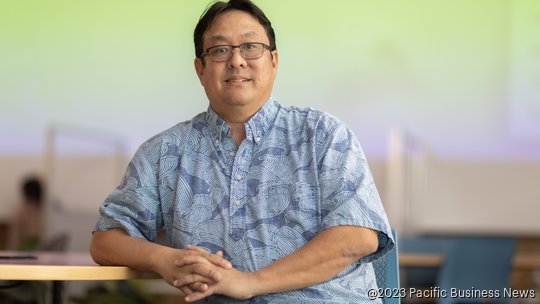
One of the projects Higashi said he is most excited about right now is a $62 million federally funded program that will provide access to capital for small businesses and startups. The program, Hawaii Small Business Capital Program, utilizes funding through the U.S. Treasury for the State Small Business Credit Initiative for various loan and investment fund offerings that include microloans for underserved businesses, and funding that is specifically geared toward community-impact projects including renewable energy and local agriculture.
HTDC also hosts events related to tech and innovation, and provides workspace for entrepreneurs, including the Entrepreneurs Sandbox coworking facility in Kakaako.
“For me, it really starts with [the idea that] tech is a part of everything and how do we use technology to make Hawaii better,” Higashi said. “As long as we are working toward that, that’s the key to success in diversifying.”
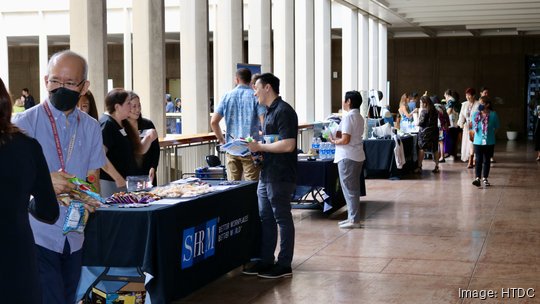
Supporting new ideas
The Pacific Asian Center for Entrepreneurship, or PACE, at UH’s Shidler College of Business exists to support students, faculty and staff who, as Executive Director Sandra Fujiyama tells it, “have an idea — whatever that idea might be.”
“We provide them with resources including educational programs, mentors, as well as funding to help them take their ideas and figure out what to do with them … and give them the resources to do it,” Fujiyama said.
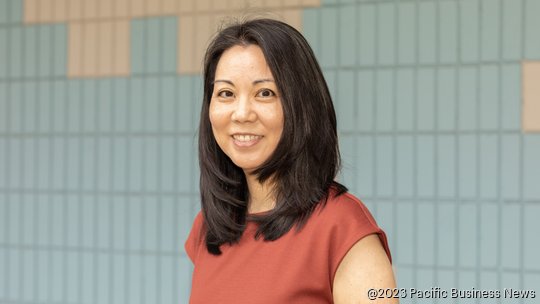
Almost all of PACE’s core programs have a chance for funding, she noted. One program, the UH Venture Competition, comes with more than $65,000 worth of cash and prizes, which Fujiyama said is provided through donors and corporate partners. Other funding through PACE includes the Calvin Shindo Student Venture Fund, a student-run venture capital fund where students choose which companies they want to invest in.
“Not only do student teams get cash to help in developing their idea, but they’ll get legal support services, marketing services, web development services, coworking space,” she said. “We’re really trying to surround them with whatever it is they might need.”
A new project for PACE is Residences for Innovative Student Entrepreneurs, or RISE, which is slated to open in the fall. The live-learn-work community will feature classroom space, prototyping labs and co-working areas, as well as dorms for nearly 400 students.

RISE, Fujiyama said, will help nurture new businesses through fostering relationships.
“It all starts with building trusted relationships with people that are mission-aligned. And that’s what we’re hoping to do with RISE — having almost 400 students that are interested in innovation and entrepreneurship make connections and build teams and come up with ideas that are solving the challenges that we have here in Hawaii,” she said.
“It's all about bringing people from different backgrounds together, having them build trusted relationships with each other around common interests. And it doesn't have to be around their business or their idea — it could be hiking, it could be the ocean. The hope is that they will … not look at it from a tech standpoint or a business standpoint, but more as ‘we are passionate about solving this problem’ … and then building a wonderful team that can then go out there and really make an impact.”
Workforce development through mentoring
DataHouse is an IT consulting business, which President Eddie Ontai explained handles “complex system issues” for clients across industries including government, education, healthcare, banking and more.
Now one of the largest IT services companies based in Hawaii, with hundreds of employees locally and in offices in Vietnam and American Samoa, DataHouse launched in 1975 with only five programmers. Ontai said that part of the reason the company’s founder, Dan Arita, created DataHouse came from “this vision of leveraging technological innovation to provide a new economy [with] higher value jobs for local people.”
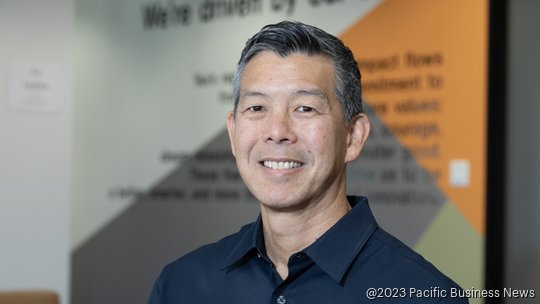
It’s a principle that lives on as the company has grown, and today, DataHouse has internship and mentorship initiatives that provide hands-on, real-world experience where the participants are “actually building something,” Ontai said. In recent years, the company has partnered with UH, the TRUE Initiative, and Transform Hawaii Government to craft a program called Community Innovation Mentorship. In its first project of the initiative, DataHouse worked with UH engineering students to develop a new check-in system and streamline the workflow for the state Department of Agriculture’s Animal Quarantine.
The program allowed the students to “actually work with the client, identify a problem, develop a solution, and deliver it before the end of their semester,” Ontai said. The final presentation for the class was to go live with the new system.
“As technologists, you want to be able to see what you built — that’s the thrill of it. … So we created actual projects that they [completed] from beginning to end with real clients that provide them real feedback for something that was going to be operational,” he said.

‘A really beautiful delivery method for learning’
In his role as the manager of the Esports Arena at Hawaii Pacific University, Jordan Oliver oversees operations at the 3,000-square-foot gaming facility, which features gaming PCs, gaming consoles, virtual reality stations, along with viewing areas, and hosts tournaments, hackathons, educational programming and more. Oliver also is the executive director of the Hawaii Esports Alliance, a nonprofit, and he’s involved with the newly formed Hawaii chapter of the Virtual Reality/Augmented Reality Association.
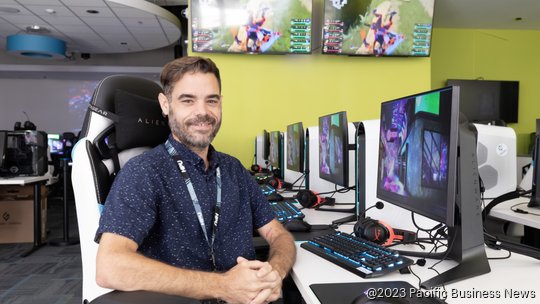
The underlying goal of his work in gaming and esports is to support workforce development. “Really, that’s the bread and butter — is to try to figure out how do we tech-enable our students [and] the current workforce to get them ready for what’s coming and what the possibilities are.”
And the possibilities related to gaming and esports, Oliver feels, are fairly endless. Of course, there are the areas that are directly related, like coding and game design. But, he pointed out, gaming has grown into a multi-billion dollar industry that also encompasses a range of other fields like marketing and event planning.
Broader still, beyond the gaming economy, Oliver said gaming and esports can entail valuable lessons for anyone — no matter what industry they want to get into — and in a format that kids are already participating in.
“It doesn’t go into just STEM. … That’s where it’s been largely focused, but it’s across the board and it touches everything. From agriculture to healthcare, this gamified process and the community that comes through gamification is just undeniable. It’s a really beautiful delivery method for learning. … The only real way to get Mario across that gap is by jumping and falling in over and over again. … There’s a lot to learn from that,” Oliver said.
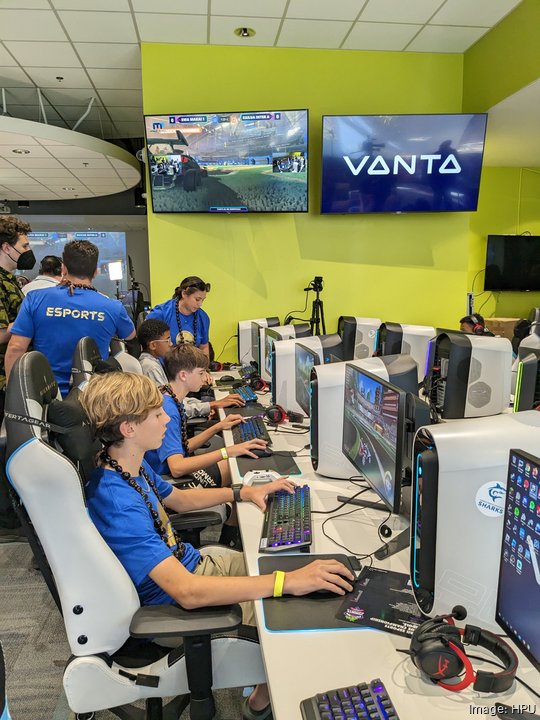
Tech education meets culture and community
When Donavan Kealoha, a managing director at an early-stage venture capital firm called Startup Capital Ventures x SBI Fund, launched Purple Maia Foundation nine years ago, he and his co-founders aimed to teach coding and computer science to youth in under-resourced areas. It began with one school in Palolo Valley. Now, the nonprofit has grown to include a range of programming that focuses on tech education through a culturally grounded, community-serving lens.
Its programs include youth education computer science courses taught in ways that are locally relevant. For example, in one class, students learn traditional Hawaiian hale building alongside front-end web development, and another teaches data science as it applies to food policy advocacy. Purple Maia also features courses on topics including design-thinking, entrepreneurship, and digital marketing, offers scholarships, and runs an accelerator for women-owned businesses and a startup incubator.
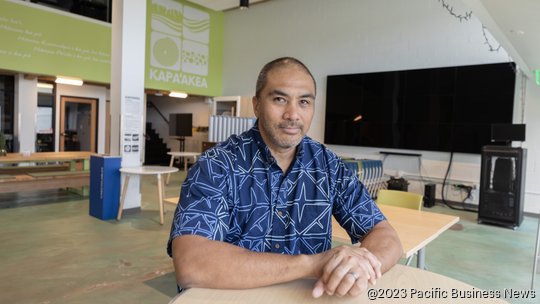
One program, Hiapo, focuses on tech workforce development for adults by upskilling and training individuals for entry-level positions in the tech industry primarily dealing with Salesforce, a customer relationship management platform. The program launched three years ago.
“Fast forward to today, we’ve gone through eight cohorts. … We’ve had about 110 folks come through and graduate, 73 of which have attained various Salesforce certifications. We’ve gotten 20 external placements and the average salary is about $82,000, with companies both based here and on the continental U.S.,” he said.
As a continuation of Hiapo, Purple Maia also created an internal apprenticeship as a way to provide additional training to program graduates through work with real clients. Kealoha said the apprentices have worked with 10 client projects, mostly for Native Hawaiian-serving organizations.
“We’ve developed pretty good software systems for [the clients], while training our folks and getting them to the point now where they have nine months experience,” he said.
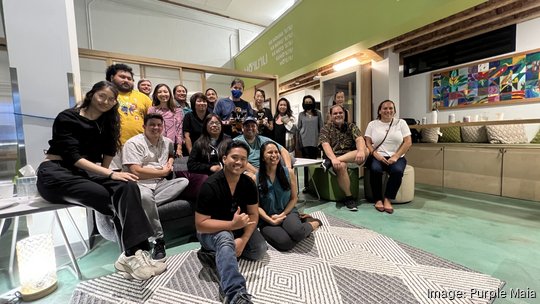
Challenges and opportunities
When asked about the challenges that Hawaii faces in diversifying the economy, Higashi prefaces his statements by saying that he doesn’t personally believe any of these issues are insurmountable obstacles. Rather, he said, these are things people commonly point to as being barriers for Hawaii. A couple of things he often hears, he said, is that Hawaii’s business climate can tend to be risk-averse, and that its geographic isolation might mean businesses don’t have as much competition — and therefore less necessity to innovate — as they might in other places.
Another challenge that panelists point to is the lack of established tech professionals who can provide the type of experience — and investment — that can help other companies progress.
“Not many people here have made their money in tech investment. Most people make it in real estate and construction, and that type of development. So in other places, there’s a lot more experience and profitability in investing into technology and taking these chances,” Higashi said.
In regard to funding, Kealoha said, “Capital will find good companies wherever you’re at.” He pointed to the example of Hohonu, a Hawaii-based startup that monitors water levels to help address climate change and recently closed on a $1.8 million pre-seed funding round. But, he noted, local accelerators, UH and Purple Maia played a role in helping the deal close. “Having advocates or folks who are representative of a community that can speak on behalf of those companies is always helpful,” he said.
As for workforce challenges, the panelists agreed that there’s no shortage of local talent.
“From what I see, I am very enthusiastic about the amount of talent from the public and HPU students, and actually all the students that come [to the arena] for tournaments. The skill and the level of entrepreneurial spirit and innovation that they have, it’s actually amazing,” Oliver said.
Similarly, Kealoha said Purple Maia’s Hiapo program, the Salesforce training initiative, has produced a lot of job-ready graduates. The challenge, however, can be landing a job afterward.
“They get the training, the skills, but what’s been difficult, in all honesty, is having folks on the demand side be willing to step up and take our folks,” Kealoha said. “We’re doing our part on the front-end training and upskilling, but we need folks on the demand side to take them on.”
It was this, he explained, that led Purple Maia to create its apprenticeship program, in order to provide an avenue for graduates to get additional, on-the-job experience.
Ontai noted that DataHouse is committed to hiring locally, particularly for entry-level roles, but, he said, “The experienced talent at the highest levels is really short on supply — and that’s globally, not just here in Hawaii,” he said. “With that, there becomes this real high demand for those good employees. ”
With tech giants going after the same talent pool as comparatively small companies like DataHouse, it can be tough to find an edge.
“It’s really, really difficult to compete at that level,” Ontai said.
“We’re going to always try to be competitive from a market standpoint. I tell candidates and existing employees that we’re going to always target 50% median income, and we do market studies twice a year to make sure that we’re keeping up to that, because that’s our obligation as an employer — to make sure we’re providing a living wage to our professionals,” he said. “But I can’t compete above that.”
Challenges aside, the panelists were much more excited to talk about the benefits and opportunities they see in strengthening local technology and innovation.
As Oliver sees it, some of the perceived challenges for Hawaii — including its geographic isolation — could actually be benefits. He said he’s seeing “a lot of interest in the value Hawaii has to bring” on the national and international stage in the esports world.
“The Asia Pacific location, it's sort of a great bridge from all these emerging technologies coming out of Asia … and Silicon Valley, Seattle and Canada,” he said. “This is such a great meeting point.”
“What I’ve seen spending so much time in Silicon Valley is you get this sort of tunnel vision, myopic view of what tech could do. It’s because a lot of folks are probably from the same place, seeing the same problems, coming up with the same solutions,” said Kealoha, who previously co-founded a materials science company and a software consulting firm. “But if you are a kid growing up in Waianae or Kau, you just have a different view of the world.”
Those unique viewpoints, panelists said, can lead to local companies solving local problems.
Fujiyama pointed back to Hohonu as an example of a company doing exactly that. “[Hohonu is] utilizing technology as well as data and software and analytics in order to help address climate change and sea level rise. … It’s a good example of how to utilize technology in the way [we’re] talking about because it’s creating a company in Hawaii that’s helping Hawaii, and it’s going to create new jobs,” she said.
“One mission of [Purple Maia] is to bring more folks into technology through education, and over the long-term, that will manifest itself into having folks who have a connection to [Hawaii] … that could then develop the next 10 to 20 [local] companies that are based here solving local problems, having global impact, and are bringing those resources back [to Hawaii],” Kealoha said.
Panelists also emphasized a point that Higashi made early on in the discussion — that economic diversification through technology can begin with helping to improve existing industries.
Ontai said it’s about using technology as a tool “to maximize value in some other domain” in order to help people “do things smarter, more efficient, and more effectively.” For instance, he said, DataHouse is working with the state Department of Education to develop technology solutions that can reduce the maintenance backlog in schools.
“It comes down to recognizing what are the assets that we have as a community and how can we leverage that and optimize the value … for [the] community and for future generations,” Ontai said.
“When I hear things like destination management … it screams technology and data,” Higashi said. “…There’s a lot of opportunities to take advantage of the resources we already have to solve the problems that matter to us most.”
Why it’s important
When it comes to why economic diversification and workforce development in tech matter, Oliver said, “it’s the natural evolution.”
“It’s going to happen around us either way,” he said. “Our students that we see come through here every day, they want to be involved in this. … And we need to enable them to do that, so they don’t leave [Hawaii], so that there isn’t a brain drain.”
Higashi emphasized the need to provide “living-wage jobs.”
“The reality of people working here in Hawaii is a lot of us live in multi-generational [homes]. We work two jobs, we work three jobs, we have side businesses — it’s just how it is. We would like for people to work one job [and] get paid a living wage so that they can afford to live here,” he said.
Kealoha thinks about the children in his life — his daughter and his nieces and nephews.
“I just want them to have optionality,” he said. “We’ve got to have optionality for our young people to … not be sort of stuck with construction or hotel [jobs] as the only choices.”
After all, Fujiyama pointed to the Covid-19 shutdowns as a cautionary look at what can happen if the state is too dependent on one industry.
“I think that’s the easiest example of why diversification is needed — we all saw what happened when tourism got shut down. So if there are ways to create opportunities for students in other areas, that’s what we’re looking for, right? We want to create opportunity,” she said. “We want to create high-paying jobs. … So, if we’re able to do that with technology and innovation and keep our students here and give them meaningful work as well as build our economy, that’s what I see as the ‘why’ we want to do it.”

